West Germany
-
- GERMAN MARINE INDUSTRY IN THE NORTH AMERICAN MARKET Maritime Reporter, Sep 1986 #60
ANSCHUETZ Circle 6 1 on Reader Service Card Anschuetz & Co. GmbH of Kiel- Wik, West Germany, designs and manufactures a comprehensive line of navigation products, including gyrocompasses, autopilots, and steering controls that have been installed on more than 9,000 ships ranging from 500,000-dwt ULCCs to 42-foot motor yachts.
Recently appointed exclusive U.S. distributor for the complete Anschuetz product line is Radio- Holland USA, headquartered in Houston with branch offices in New York, New Orleans, Mobile, Long Beach, and Corpus Christi.
Radio-Holland USA, B.V. offices are in the following locations: New York—90 Route 22, Springfield, N.J. 07081, (201) 379-2660, telex 132034; Houston—6033 South Loop East, Houston, Texas 77033, (713) 649-1048, telex 795428; Long Beach—1965 Spring Street, Long Beach, Calif. 90806, (213) 595-0039, telex 181584; New Orleans—5515 Pepsi Street, Suite C, Harahan, La.
70123, (504) 773-4024, telex 784433; Mobile—701A South Conception, Mobile, Ala. 36603, (205) 432-3109, telex 782737; and Corpus Christi— 3206 Reid Drive No. 12A, Corpus Christi, Texas 78404, (512) 851- 9390.
BLOHM + VOSS Circle 62 on Reader Service Card Blohm +Voss AG of Hamburg, an integrated engineering and construction group, specializes in the design, building, repair, and conversion of mobile and stationary offshore units for exploration and production, offshore service and construction vessels, topside facilities modules, cargo vessels, specialpurpose ships, and floating drydocks.
B + V's U.S. operation, Blohm + Voss Company, Inc., is located in Springfield, N.J. The Canadian representative is COM Contractors & Engineers Inc. in Halifax, Nova Scotia.
The B + V product line includes the well-known Stuelckenmast® cargo gear systems, Accommodation System M1000®, tools for oil/gas exploration, and plant and components for energy systems. The company also offers project management, engineering services, consultancy, and system technology for shipyards and industrial plants.
DEUTZ MWM Circle 63 on Reader Service Card Following the acquisition of the majority of the shares of Motoren- Werke Mannehim AG by Klockner- Humboldt-Deutz AG of Cologne, the engine sales programs for both companies have been coordinated.
For marine applications, the new company offers a broad range of medium-speed and high-speed water-cooled engines with outputs of up to 9,722 bhp. New engines in the program are those of Series 234 and Series 604 B.
This merger brings together two of the world's major engine manufacturers, with a combined reputation for quality, durability, and service excellence, serving both North America and the world market. The North American headquarters of the new company is in Montreal, with a division based in Atlanta, Ga.
The Deutz MWM 234 Series represents the state of the art in modern high-power, high-speed diesel engine design in the range of about 135 to 1,210 bhp output. Decisive advances have been made with this development in terms of space/ weight ratio, power/weight ratio, fuel consumption, and durability.
This series of water-cooled V-type engines with six to 16 cylinders is available in turbocharged versions with charge air cooling and, if required, naturally aspirated. The compact design is said to be a great advantage for the naval architect, allowing greater flexibility and ease of servicing to be achieved with less effort. The power per volume is 552 kw/cubic meter, and the weight to power ratio is 2.1 kg per kw. These advantages make the 234 Series a good choice for several marine applications.
The 604 B engine family, presented for the first time in the spring of 1985, was derived from the 603/604 family. Without changing the outer dimensions, the stroke and bore could be enlarged from 185 to 195 mm and 160 to 170 mm, respectively. This permitted, in combination with a small increase in the mean effective pressure, a 30- percent uprating to a mep of now approximately 18 bar. The maximum power per cylinder was set to 161 bhp at a speed of 1,800 rpm. For main propulsion and auxiliary drive, the engine range includes a 6-cylinder in-line unit and models in 90- degree Vee configuration available as 8-, 12-, and 16-cylinder units that are rated for a maximum power of 2,575 bhp.
The Vee engines have, in the Vee space, exhaust manifolds with insulated sheetmetal covering. Charge air manifolds within the engine outlines, which require no insulation, permit a comparatively narrow construction.
The power per unit volume of about 220 kw/cubic meter is correspondingly high.
In the spring this year Deutz MWM filed an application with Germanischer Lloyd and other leading classifications societies for approval of the TBD 604 B engine family. The firing pressures approved by the societies are well above the maximum levels experienced in field operation. Accordingly, the moving parts of the engines exhibit an adequate safety reserve as well as development potential.
GRANGES Circle 64 on Reader Service Card Granges Repair Service in Hamburg has more than 40 years of experience in crankshaft grinding in its modern workshop and on-site repairs aboard ship, grinding crankshaft pins and main and thrust bearings of diesel engines without dismantlement of the shaft.
The company is a specialist for worn or heavily cracked pistons (aluminum and steel), cylinder covers, valves, guaranteed crack welding, etc. It offers flame-hardened or chrome-plated ring grooves.
Granges provides worldwide service, with all precision grinding, boring, and milling machines packed in air baggage.
JASTRAM Circle 65 on Reader Service Card The Research, Development and Engineering Department of Jastram- Werke GmbH KG in Hamburg offers a free full-color literature package on its facilities and capabilities, and on the services the company provides for a wide range of activities relating to oil recovery and wastewater purification. This includes recovery of oil from accidental spills, harbor cleaning, skimming oil off water surfaces, and separation technology.
Color photographs illustrate activities in connection with oil recovery fields, as well as various products designed and developed by Jastram.
One photo shows the turning circle of a highly maneuverable ship fitted with a Jastram T-rudder, which can turn around at full speed in a circle of less than two ship lengths.
The literature package also contains some 12 leaflets that discuss and thoroughly explain, with many illustrations, the Jastram oil recovery and separation process.
Michigan Wheel Company of Grand Rapids, Mich., markets the Michigan-Jastram transverse thruster to the North American market.
KRUPP ATLAS Circle 66 on Reader Service Card A 12-inch AC/TM rasterscan radar designed for either stand-alone or integrated installation aboard all types of small commercial, naval, and fishing vessels, the Atlas 5600 was introduced recently by Krupp Atlas Elektronik (KAE) of Bremen.
The German company's U.S. operations are based in Rahway, N.J.
Combining continuous radar presentation and dedicated data display functions on a single 44-cm, high-resolution screen, the 5600 system offers one or more viewers uninterrupted true daylight viewing of a quality said to be superior to a conventional TV picture.
The system incorporates a new centered TM display mode that eliminates the disadvantages of true motion presentation by maintaining own ship's position fixed on PPI while indicating moving targets with their true tails.
Other main functions include manual acquisition of up to 10 targets, and semiautomatic plotting with target data readout, including CPA and TCPA. An EMB-positioned navigation line and a trail maneuver facility for rapid prediction and assessment of surrounding traffic conditions are among other features, which also include comprehensive self-check procedures in addition to flexible interfacing arrangements for other navigational sensors and processing systems.
The development of the 12-inch 5600 follows closely on the introduction of the Atlas 7600/8600 series of rasterscan radars, which are said to be the first of their type to offer continuous true daylight viewing on a 16-inch screen under all ambient conditions. Comprising RM, TM, and two ARPA models, all are designed to meet or exceed IMO and USCG specifications, and are FFF type-approved.
The 7600 RM and TM systems both allow manual acquisition of up to 10 targets, as well as semiautomatic plotting with target data readout, including CPA and TCPA.
The 7600 ARPA also provides full automatic tracking functions.
The 8600 ARPA permits manual acquisition of up to 20 targets with automatic tracking and target data readout, including CPA and TCPA.
The system also features automatic acquisition and tracking of up to 40 targets with guard zones and limitation lines.
Other developments from KAE include the NACOS 20 series of integrated bridge control systems designed for one-man operation and precise navigation at reduced cost.
Typically comprising two rasterscan radars, a doppler log, echo sounder, and an adaptive radar-controlled autopilot, the central control console also incorporates a full-color navigation information display, to- gether with interfaces for other sensors and bridge equipment. The NACOS systems were developed partly under sponsorship of the West German Ship of the Future project.
KRUPP MaK Circle 67 on Reader Service Card Since beginning operations in 1980, Krupp MaK Diesel Inc., the North American subsidiary of Krupp MaK Maschinenbau GmbH of Kiel, West Germany, has been a successful force in the North American marine market. With total engine sales exceeding 110 units, Krupp MaK has supplied diesels to a wide variety of customers, both on sea and land. These range from small fishing vessels to the largest ferry ever built in North America; from power stations within the Arctic Circle to a heavy-fuel towboat operation on the Mississippi River.
At its headquarters conveniently located next to Toronto International Airport in Canada, MaK has a comprehensive stock of spare parts backed up by factory-trained service engineers to respond immediately to customer needs. Additional spares can be supplied from Kiel, where 96-percent spares availability is maintained, within 24 hours.
Krupp MaK four-stroke, medium- speed diesel engines, designed and built to operate on heavy fuels of up to 700 cSt, cover an output range of 700 to 13,500 bhp in five engine types with bores ranging from 240 to 580 mm at speeds of 1,000 to 425 rpm. The entire engine range has been carefully planned to insure that all power requirements can be met with in-line engines (Vee engines of 12 and 16 cylinders are available for very compact drive systems) in order to reduce and simplify maintenance.
MAN B&W Circle 68 on Reader Service Card MAN B&W Diesel GmbH of Augsburg, West Germany, as the world's largest designer of marine diesel engines, has developed engines with the highest thermal efficiency, while at the same time maintaining a high level of service reliability.
With the introduction of the MC low-speed series, MAN B&W brought the fuel consumption down to 118 grams per bhp-h. Compared with the 156 g/bhp-h some 10 years ago, this means a reduction of about 25 percent. At the same time the revolutions of the direct-coupled propeller have been reduced from 114 rpm to 60 rpm, leading to an increase in propeller efficiency of 12-15 percent. These factors combined mean a total savings in the fuel consumption on propulsion engines of up to 40 percent.
During the development of the new four-stroke, heavy-fuel L58/64 engine, particular emphasis was placed on low fuel consumption, high reliability in unrestricted operation, simple and easy maintenance, adaptability to varying operating and environmental conditions, and good fuel ignition qualities. The L58/64 engine will be produced as in-line units with six, seven, eight, and nine cylinders, providing a power range (mcr) from 9,900 to 14,850 bhp.
About a year ago, MAN B&W delivered the first 6L 58/64 engine; five engines with a total of more than 50,000 bhp are currently in operation on four ships. These are two containerships each with one 6L58/64, a 127,000-dwt bulk carrier with a 6L 88/64, and a 261,500-dwt VLCC with two 8L 58/64 units.
The excellent cost-effectiveness of this engine is the result of a modern four-stroke design, an extremely low fuel consumption rate, and low maintenance costs.
The first engine has already logged more than 5,000 operating hours, and a total of 14,000 hours of operating experience has now been achieved. The results obtained during this period are said to be excellent.
With a specific fuel consumption of only 123 g/bhph, daily consumption rates of 24 tons are being recorded on one of the containerships at an average speed of 16.5 knots. The owners are particularly pleased with the favorable lube oil consumption of this engine.
The MAN B&W orderbook currently consists of 18 engines with a total of 231,490 bhp. These include 11 engines on order and seven units ordered from three licensees.
M.A.N.-GHH Circle 70 on Reader Service Card GHH in Blexen, Germany, is one of the oldest builders of drydocks in the world; floating docks have been on the company's program since 1878. During one 12-month period a few years ago, the yard designed, built, and delivered a 30,000-ton and a 20,000-ton dock for owners in the U.S., as well as a 22,000-ton and a 10,000-ton dock for Saudi Arabia.
Last year GHH delivered the 22,000-ton floating drydock Mission Bay to Continental Maritime of San Francisco. Noteworthy about this dock is that it complies with the damage stability requirements in accordance with Mil Std 1625. The dock has been designed to accommodate both the modern U.S. Navy combatants such as the DDG-51, and also commercial ships up to Panamax size. It features a unique remote-controlled bilge block system that allows easy adaptation to the various hull forms of modern Navy ships.
The M.A.N.-GHH facilities, on the bank of the Weser River across from Bremerhaven, have good access to the open sea. It has large fabrication shops to preassemble dock modules, as well as a slipway of more than 1,200 feet in width to accommodate construction and launching as a single unit docks of any kind or size. At launching, docks are already completely outfitted and ready for towing to final destination.
Besides custom-design and building of docks by in-house specialists, GHH offers additional services such as consultation for anchorage and offsite preparation, towing to the site at fixed prices, training of personnel for dock operation, and assistance in securing long-term financing.
The management of the Dockbuilding Division, including engineering and sales, is located at M.A.N.-GHH headquarters in Oberhausen-Sterkrade. The German company is represented in the U.S. by American M.A.N. Corporation in New York, with branch offices in Houston, San Francisco, and Seattle.
MTU Circle 72 on Reader Service Card MTU of North America, Inc. is the U.S. subsidiary of MTU Motoren- und Turbinen-Union Friedrichshafen in West Germany, a member of the Deimler-Benz group. The MTU diesel line covers a power output range of 440 to 10,000 bhp at rated speeds between 1,000 and 2,400 rpm. Basic design features common to the series include Vee configuration, water cooling, exhause gas turbocharging, and charge air cooling.
A great number of MTU engines have proven themselves worldwide.
More than 32,000 units are currently in service in locomotives, vehicles, and stationary machinery. Because of their compact design and favorable power/weight ratio, MTU engines are well known in the international shipping industry for main propulsion plants and ship's service generating systems; their modern technology and high reliability are highly regarded in the industry.
There are more than 14,000 MTU engines in more than 120 countries for merchant marine and governmental service.
Applications range from tugs and fishery vessels through ferries for automobiles, trains, and passengers; hydrofoils and catamarans to offshore supply boats and fireboats, through high-speed, paramilitary and naval vessels such as fast patrol boats, corvettes, frigates, and craft for special duties such as coastal patrol boats, submarines, etc.
MTU also offers system engineering for complete propulsion systems in CODAD, CODAG, or CODOG configuration, and supplies all necessary components—including the shafting and propeller equipment, marine gears and couplings, as well as the electronic monitoring and control systems.
Over the past several years, MTU of North America has obtained increased penetration in the U.S. market.
The main activity is propulsion of fast vessels in the power range of 700 to 3,300 bhp based on the 396 engine series. These fast vessels include crewboats, pleasure craft and, with increasing interest, ships to transport passengers.
Service outlets in Miami and Fort Lauderdale provide a sound basis for continued expansion; plans for intensified product support operations are under way.
NEUHAUS Circle 73 on Reader Service Card J.D. Neuhaus Hebezeuge in Witten- Heven, West Germany manufactures a line of trolley-mounted air hoists for 4 bar and 6 bar air pressure.
The JDN Profi series has lifting capacities from 220 pounds to 100 tons, and air pressure of 6 bar. They can be mounted or suspended on trolleys.
The B and M series, with lifting capacities from 1 to 12 tons, are for 4 bar air pressure. Depending on their lifting capacities, JDN hoists are operated by hand or by reel chain, or are fitted with an air motor.
All JDN air hoists are said to be particularly suitable for use in confined spaces and where there is a risk of explosion.
The German company is represented in the U.S. by Neuhaus America Corporation in Sparks Glencoe, Md.
PLATH Circle 97 on Reader Service Card C. Plath of Hamburg, a division of Litton Industries, Inc., offers free literature on its Naviglobe Global Positioning System (GPS) satellite navigation receiver.
The informative literature explains what the GPS is, how it works, and how GPS user equipment processes pseudorange measurements and satellite positions to estimate three-dimensional user position and time. Features and performance of the Naviglobe are discussed and technical data is listed, including navigation signal, dynamic capability, interference immunity, reaction time, accuracy, interfaces, dimensions, and power requirements.
The publication points out that the main advantage of the Naviglobe, which was developed within the Litton Group by Plath in cooperation with a sister company, is its layout for simple operation. Without knowledge of the operator's position, time, special chart, or calibration, Naviglobe will indicate continuously its position with highest accuracy shortly after switching.
Photos of the Naviglobe control display unit and receiver processor unit are included in the brochure.
RENK Circle 98 on Reader Service Card One solution for obtaining overall higher efficiency and lower electrical power costs aboard ship is by driving a constant-speed generator off the main propulsion engine, which is operated at varying speeds when driving a fixed-pitch propeller.
Zahnraederfabrik Renk of Augsburg, West Germany, has developed a special gear system able to accomplish that result. The U.S. subsidiary of the German company is Renk Corporation in Duncan, S.C.
Falk Corporation of Milwaukee is licensed by Renk to manufacture a marine reverse/reduction gear of Renk design in the power range of 1,000 to 7,000 hp that is marketed as the Falk RW gear. The two companies also cooperate on special projects.
The company's RCF (Renk Constant Frequency) unit is a differential epicyclic gear capable of insuring constant-speed drive to the power generator in a fully automatic mode. This gear is usually mounted on the forward end of the engine crankshaft. The RCF allows a flexible layout in five different positions of the generator system, depending on the space available in the engine room. An additional possibility is to install the RCF along the propeller line on the main engine power takeoff side.
The RCF's speed superposition is achieved by hydrostatic or electric control. The basic gear ratio is chosen so as to obtain generator synchronous speed output for a standard frequency generator at 85 percent of the engine rated speed. In this way the controls of the RCF will drive the generator at constant speed while the main engine is operating between 70 and 100 percent of its rated speed. The annulus of the epicyclic gear will remain fixed while the engine is running at 85 percent of its rated speed; in this case the power transmission is merely mechanical.
SCHOTTEL Circle 1 on Reader Service Card The range of products manufactured by Schottel-Werft (Josef Becker GmbH & Co. KG) of Spay, West Germany, include: Schottel- Rudderpropellers with fixed or controllable- pitch propellers that can be steered through 360 degrees; Schottel-Navigator type units; Schottel-Transverse thrusters (also available with adjustable-pitch propellers); and Schottel-Jet systems for main propulsion or as a maneuvering aid to meet the requirements of inland waterways, sea navigation, and the offshore industry.
The recently delivered tractor tug Brooks K. McAllister, built for McAllister Brothers Inc. by Offshore Shipbuilding, is fitted with two Schottel rudder-propeller drives driven by twin Electro-Motive division 16-645EZ diesel engines.
This propulsion design features two right-angle drive units located under the stern of the vessel.
Each unit can rotate 360 degrees to provide virtually immediate and complete control of thrust and direction.
The propellers are enclosed in nozzles to further enhance the bollard pull of the tug.
The Schottel rudder-propeller system produces a high degree of maneuverability and power that provides substantially increased economy and safety for the new tugboat.
This advanced tractor tug, though common in most European and Far East ports, is said to be the first placed in service on the U.S.
East Coast. She is now performing ship docking service in the Port of Jacksonville, Fla.
The Schottel system transforms engine output into optimum thrust by use of specially designed gears and a proportional propeller. Full thrust is provided to move the tug almost instantly in any direction by rotating the lower gearbox, without power loss, and with maximum maneuvering capability at full power ahead, astern, and laterally. Turning circles and stopping distance at full power can be executed in approximately one tug length.
Power is transmitted by the Rudderpropeller through silent-running, spiral-bevel gears; packing seals are fitted throughout. Fixed or controllable-pitch propellers are of the push-type, designed to suit the individual vessel. For tugboat propulsion, most of the units are fitted with nozzles to increase thrust.
Schottel Rudderpropellers are available in a power range from 27 to 6,000 bhp.
Other Schottel products, the Cone-Jet and Pump-Jet, have been specially developed as steerable propulsion units and maneuvering aids for shallow-draft vessels. Such vessels include river ferries, floating plants, pontoons, and amphibious craft. The jet units are integrated into the hull and fully protects against damage by grounding. The unit produces a jet stream for optimum thrust that is steerable through 360 degrees, thus giving propulsion in any direction. Over the years Schottel jet units have proved themselves, under the most adverse conditions, all over the world.
SIEMENS Circle 2 on Reader Service Card Siemens AG of Hamburg has been a supplier of a wide range of electrical and electronic equipment and services to the marine industry for more than a century. The German company is represented in the U.S. by Siemens Energy and Automation, Inc. of South Plainfield, N.J.
One of the most recent orders for the U.S. market was from Pennsylvania Shipbuilding for the power takeoff generating systems for the three fleet oilers (T-AO-191, 192, and 194) that the Chester, Pa., shipyard is building for the U.S. Navy.
Each shipset consists of two 2,500- kw, constant-frequency generators driven by PTOs off the main engine reduction gear. The function of each system can be reversed, allowing the PTO generators to serve as motors for emergency "take-home" propulsion.
Another big order was from Bay Shipbuilding Corporation in Sturgeon Bay, Wise., to supply the majority of the automation equipment, including the consoles, for the three containerships under construction for Sea-Land Service. The first of these ships will be delivered later this year, with the other two following in 1987. Another Sea-Land order was an on-board retrofit project in which Siemens upgraded four existing containerships to operate with unmanned engine rooms (UMS).
Another recent order, via MaK Diesel, was for supplying the alternators for the two T-AGS surveying ships under contract to Bethlehem Steel's Sparrows Point yard for the U.S. Navy.
Siemens also supplied the engine control consoles, complete with an alarm and monitoring system laid out for 340 inputs, for the 12 Econoships built for United States Lines by Daewoo Shipbuilding. These vessels, the largest containerships in the world, are now operating in USL's round-the-world service.
Siemens also provided a constantfrequency shaft generator of 2,000 kw for each of the six containerships being built in Japan for Lykes Bros.
Steamship Company of New Orleans.
Circle 3 on Reader Service Card J.M. Voith, GmbH, headquartered in Heidenheim, is one of the leading German manufacturers of heavy machinery, with worldwide production facilities, including the U.S.
Its main products, in addition to the well-known Voith-Schneider propeller (VSP), are paper machines and equipment for pulp preparation, large water turbines and pumps for hydropower and storage power stations, power transmissions, torque converters, hydrodynamic couplings, reduction gears, fully automatic gears, cardan shafts, etc.
The VSP is a vertical-axis propeller for the highest degree of reliable maneuverability. Pitch is controlled by two independent coordinates (hydraulic rams)—one for the longitudinal, the other for the transverse ship axis. This guarantees very simple and precise handling of ships equipped with the VSP. Extremely low rpm (only about one-quarter of a comparable screw propeller) and highest quality of forged chromenickel steel blades result in a very rugged and reliable shipboard machine, highly resilient against impact with floating debris.
Voith-Schneider propellers are used wherever high and precise maneuverability is required. Typical applications are: Voith Water Tractors—a tugboat concept developed by Voith—with highest shiphandling capabilities and safety. There are some 500 Voith Water Tractors now in operation in 95 harbors worldwide.
Double-ended ferryboats, with one propeller forward and one aft.
They are not only highly maneuverable but also can compensate with their propellers against strong side winds and currents when safe and precise entering into terminals is required. About 300 VSP-equipped ferries, on most major routes, are operating worldwide. Two of the most recent to enter service are the ferries built by Robert E. Derecktor shipyard for the City of New York's Department of Transportation.
With a passenger capacity of 1,200 each, their primary use is for offpeak passenger-only travel between Manhattan and Staten Island.
For minehunting vessels, VSPs are used as main and auxiliary drive and steering device all in one for cruising, precise position-keeping, and maneuvering with low underwater noise signature during minehunting between zero and seven knots. With these vessels, the propellers are arranged side-by-side astern.
WESTFALIA Circle 5 on Reader Service Card Westfalia Separator AG of Oelde/ Westfalia, West Germany, designs and manufactures equipment and systems for every oil purification need. Westfalia products are marketed in the U.S. by Centrico, Inc. of Northvale, N.J. Centrico provides expertise to help design, install, and service Westfalia equipment.
Skilled engineering advice and assistance, as well as parts, are usually available overnight at any port on the Atlantic, Pacific, or Gulf Coasts.
Westfalia oil purifiers are available as single machines or as preassembled "Centri-Pack" modules, with heaters, pumps, strainers, controls, wiring, etc., installed and ready to go. Westfalia systems allow monitoring of such vital functions as oil flow, oil temperature, increased water discharge, oil break-over, failure to shoot, motor temperature, vibration, and excessive number of second-stage solids or water discharges.
Control stations, with audible and visual alarms, can be located remotely and/or at the equipment.
Westfalia oil-purifying centrifuges, including the automatic, selfcleaning model OSA 20 and the take-down OTB 2 version, are being increasingly specified by diesel engine manufacturers and shipbuilders for workboats, service vessels, and offshore platforms.
By removing water solid fines and other impurities from heavy fuel oil, Westfalia purifiers permit efficient combustion of the low-cost grades of fuel. Put to work eliminating similar contaminants from lube oils, they also enable operators to recycle lube oils, thus forestalling premature engine wear and reducing downtime, as well as extending lube oil life.
Westfalia OSA models are especially suitable for automatic, continuous operation. They incorporate self-cleaning, disc type bowls designed for optimum oil-water separation even when oil characteristics and feed rates change. OSA models are available with maximum rated capacities of 5,500 gph, but actual throughput depends on viscosity, specific gravity, and other properties of the oil.
Westfalia OTB take-down oil purifiers are designed for dewatering and removal of solid impurities from fuel and lube oils. They are currently in use on many offshore service vessels in the Gulf of Mexico area, and on other workboats throughout the world.
ZF Circle 4 on Reader Service Card Zahnradfabrik Friedrichshafen AG of Friedrichshafen, West Germany, offers an attractive color brochure describing its ZF marine transmission systems. The 16-page publication is arranged in seven double-page sections.
ZF marine gearboxes, used by eight of the 10 West European navies on their fast craft, incorporate the comprehensive experience de- rived from all phases of transmission work, and the close cooperation and intensive exchange of ideas between ZF development departments and engine manufacturers and shipyards worldwide.
ZF invests a large and everincreasing proportion of its annual turnover in research and development.
Intensive testing is an integral part of all development, research, and production phases. Test teams are at work constantly in laboratories, at test rigs, and in the field. A highly qualified production staff has the necessary experience, and a very high standard of quality is achieved by a sophisticated quality assurance system.
Among the advantages of ZF marine gearboxes noted in the brochure are: small dimensions and maximum torque; use of expertly and carefully selected materials; lubricants carried to gears and bearings at the optimum rate through purpose-designed pressure systems; quiet running; lightweight but robust; rapid-acting clutches; easy servicing and overhauling; and reliability and long life.
Shown in cutaway drawings are ZF gearboxes for fast craft, workboats and crewboats, Navy vessels, port authority craft, lifeboats, ferries, and passenger vessels.
ZF is represented in the U.S. by ZF of North America, Inc., Lincolnshire, 111.
-
- Multipurpose Cargo Ship Launched At Jansen Werft Yard Maritime Reporter, Dec 1986 #73
The multipurpose cargo vessel Nordland (hull no. 179) contracted by Nordland Schiffahrtsges. mbH of Dorpen, West Germany, was recently christened and launched at ceremonies held at Jansen Werft's Leer yard in West Germany. The sponsor of the vessel was Miss Tiina Valve, daughter of Veijo Valve,
-
- Seebeckwerft Receives $38.9-Million Order To Build Rail Ferry Maritime Reporter, Sep 1988 #57
Seebeckwerft of Bremerhaven, West Germany, recently received a DM65-million ($38.9-million) order from the Railship Group to build a 10,000-dwt rail/freight ferry. She is the third ferry of this type to be ordered by Railship from Seebeckwerft over the last few years. The vessel, the Railship III
-
- M.A.N.-GHH To Build Floating Drydock For Polish Shipyard Maritime Reporter, Feb 1986 #7
GHH was completed for a Gdansk customer in 1877. The Dock is still in service today, though it has been moved to Howaldtswerke- Deutsche Werft AG in West Germany. Contract price of the new dock is about $20 million. It will have an overall length of 800.5 feet, length over keel blocks of 771 feet, inside widt
-
- Hapag-Lloyd (America) Announces Change Of Chief Executive Maritime Reporter, Apr 1983 #44
The executive board of Hapag- Lloyd AG, Hamburg, West Germany, recently announced that Hans D. Druegg, president and chief executive officer of Hapag- Lloyd (America) Inc., will assume an executive position in Hapag-Lloyd's European marketing and sales organization. He will be succeeded in his prese
-
- Microphor Europe GmbH Formed In Europe By Microphor And German Firm Maritime Reporter, Mar 1983 #83
on the European continent and the United Kingdom. The agreement licenses the company also to manufacture and market Microphor marine equipment in West Germany. Ken J. Bassham, European area general manager for Microphor, Inc., and Horst Werner, sales manager for Thyssen, have been named managing directors
-
- Jurgen Manske Named Representative For Hapag-Lloyd Service Maritime Reporter, Jul 15, 1980 #24
Jurgen Manske has been appointed owner's representative for Hapag-Lloyd's U.S. Gulf Service, replacing Peter Zehler, who has returned to West Germany for reassignment with the steamship line. Based in New Orleans, Mr. Manske will be responsible for agency coordination for the entire Gulf
-
- LNG-5 . . . Dusseldorf Maritime Reporter, Jun 15, 1977 #12
to attend the Fifth International Conference and Exhibition on Liquefied Natural Gas (LNG-5) scheduled August 29- September 1, 1977, in Dusseldorf, West Germany. Aman R. Khan, a vice chairman of the conference and executive advisor on international programs for the Institute of Gas Technology, said
-
- GASTECH 85 Maritime Reporter, Oct 15, 1985 #32
, Total Exploration- Production, Paris. K. Kokkinowrachos, professor of ocean engineering, Technical University of Hamburg-Harburg & Head, West Germany. S. Yoshii, general manager, Technical Research Centre, Japan National Oil Corporation, Tokyo. J. English, special projects manager, Can-Dive
-
- Nineteen N e w Members Elected To American Bureau Of Shipping Maritime Reporter, Nov 1985 #109
at ABS headquarters in New York City on September 23, 1985. The new Members are: Klaus Ahlers, chairman, Howaldtswerke- Deutsche Werft AG, Kiel, West Germany. Ralph Anselmi, president, Tampa Shipyards Inc., Tampa, Fla. Marshall Ballard, general superintendent, Penrod Drilling Company, Dallas, Texas
-
- Sulzer Diesels Will Power Townsend Cross-Channel Passenger/Vehicle Ferries Maritime Reporter, Jun 1986 #99
be built by CCM Sulzer of Mantes, France, for its large cross- Channel, passenger/vehicle ferries. Ordered from Schichau Unterweser AG in West Germany, the two new vessels will each have three 14- cylinder engines having a combined output of 31,500 bhp at 510 rpm. Each engine will drive a controllab
-
- GE's LM2500 Engines To Power Portuguese Frigates Maritime Reporter, Dec 1986 #50
for six engines to be delivered to both Blohm & Voss shipbuilders in Hamburg, West Germany, and Howaldtswerke- Deutsche Werft shipyard in Kiel, West Germany, beginning in 1988. Ship deliveries to Portugal will take place over the next two to three years. These ships will be the first MEKO-type frigates
-
 )
March 2024 - Marine Technology Reporter page: 39
)
March 2024 - Marine Technology Reporter page: 39Photo courtesy Global Ocean Design Figure 7 A 35Ah AGM lead-acid battery is tested using the West Mountain Radio CBA to show the effect of simply ? lling the battery voids with mineral oil as a compensating ? uid. The CBA is programmed to cut-off at a voltage of 10.50v. The top line (red) shows the
-
 )
March 2024 - Marine Technology Reporter page: 38
)
March 2024 - Marine Technology Reporter page: 38LANDER LAB #10 Photo courtesy West Mountain Radio Photo courtesy of Clarios/AutoBatteries.com Figure 6 The West Mountain Radio Computerized Battery Analyzer (CBA V) attaches to a Figure 5 laptop by a USB-B cable, and to a battery by Powerpole® Connectors. Exploded view of an AGM lead-acid battery.
-
 )
March 2024 - Marine Technology Reporter page: 37
)
March 2024 - Marine Technology Reporter page: 37will advance with succeeding charging cycles, presumably due to gas generation during recharge. A battery capacity test, described below with the West Mountain Radio CBA V, can be done to replicate this experiment yourself. (See Figure 7.) ? Gel cell Sealed Lead-Acid (SLA) batteries substitute a
-
 )
March 2024 - Marine Technology Reporter page: 26
)
March 2024 - Marine Technology Reporter page: 26FEATURE OCEANOGRAPHIC INSTRUMENTATION & SENSORS Kevin Mackay, TESMaP voyage leader and Center head of the South and West Paci? c Regional Centre of Seabed 2030. Kevin in the seismic lab at Greta Point looking at the Hunga Tonga-Hunga Ha’apai volcano 3D map completed with data from the TESMaP voyage
-
 )
March 2024 - Marine Technology Reporter page: 25
)
March 2024 - Marine Technology Reporter page: 25collecting (formerly known as Lo`ihi, the youngest suggest the volcano was still erupting, video images of the eruption’s impact. volcano in Hawai`i) and West Mata vol- with a dense ash layer found in the up- Equipment on board included a deep- cano in the Tonga arc. “We’ve seen a ton per water column near
-
 )
March 2024 - Marine Technology Reporter page: 6
)
March 2024 - Marine Technology Reporter page: 6MTR Editorial Advisors Gallaudet Hardy The Honorable Tim Gallaudet, Kevin Hardy is President PhD, Rear Admiral, U.S. of Global Ocean Design, Navy (ret) is the CEO of creating components and Ocean STL Consulting and subsystems for unmanned host of The American Blue vehicles, following a career
-
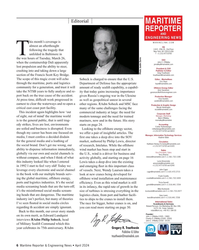 )
April 2024 - Maritime Reporter and Engineering News page: 6
)
April 2024 - Maritime Reporter and Engineering News page: 6Editorial MARITIME REPORTER AND ENGINEERING NEWS his month’s coverage is M A R I N E L I N K . C O M almost an afterthought HQ 118 E. 25th St., 2nd Floor following the tragedy that New York, NY 10010 USA T +1.212.477.6700 Tunfolded in Baltimore in the wee hours of Tuesday, March 26, CEO John C.
-
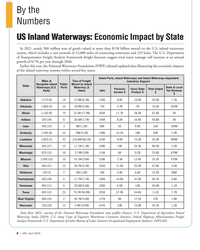 )
April 2024 - Marine News page: 8
)
April 2024 - Marine News page: 8260 (28)617.7M (7.7B)184K14.8B31.9B65.7B4.8B Tennessee 950 (11)529.5M (5.6B)100K6.5B12B26.4B1.1B Texas 830 (13)2379.7M (54.9B)305K27.9B54.6B111B7.7B West Virginia 680 (16)245.7M (3.4B)127K8B17.1B37B1.8B Wisconsin 230 (29)121.9M (107M)147K10B15.8B34.1B1.2B Data from 2021, courtesy of the National Waterways
-
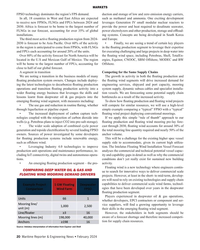 )
February 2024 - Maritime Reporter and Engineering News page: 20
)
February 2024 - Maritime Reporter and Engineering News page: 20MARKETS FPSO technology dominates the region’s FPS demand. duction and storage of low and zero emission energy carriers, In all, 18 countries in West and East Africa are expected such as methanol and ammonia. One exciting development to receive new FPSOs, FLNGs and FPUs between 2024 and leverages
-
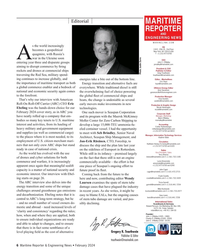 )
February 2024 - Maritime Reporter and Engineering News page: 6
)
February 2024 - Maritime Reporter and Engineering News page: 6Editorial MARITIME REPORTER AND ENGINEERING NEWS M A R I N E L I N K . C O M s the world increasingly HQ 118 E. 25th St., 2nd Floor becomes a geopolitical New York, NY 10010 USA T +1.212.477.6700 quagmire, with Russia’s Awar in the Ukraine soon CEO John C. O’Malley entering year three and disparate
-
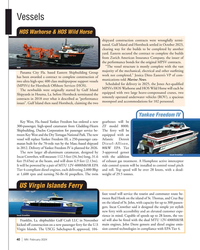 )
February 2024 - Marine News page: 40
)
February 2024 - Marine News page: 40vehicles (ROV), a spacious issues”. Gulf Island then sued Hornbeck, claiming the two moonpool and accommodations for 102 personnel. Yankee Freedom IV Key West, Fla.-based Yankee Freedom has ordered a new gearboxes will be 300-passenger, high-speed catamaran from Gladding-Hearn ZF model 8000. Shipbuilding
-
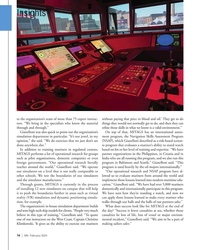 )
February 2024 - Marine News page: 14
)
February 2024 - Marine News page: 14believe in this type of training,” Gianelloni said. “To quote casualties be loss of life, loss of vessel or major environ- one of our instructors on the West Coast, Captain Christine mental incident,” Gianelloni said. “We aim to be a part of Klimkowski, ‘It gives us the ability to exercise our mariners
-
 )
January 2024 - Marine Technology Reporter page: 56
)
January 2024 - Marine Technology Reporter page: 56the main issues of fabrication, assembly, as well ning include Europe, which represents 60GW of potential;. as the issues with very deep waters on the West Coast of the Asia Paci? c and its 81GW of potential; and then North Amer- United States where we have one kilometer or more. [The ica, where we’re
-
 )
January 2024 - Marine Technology Reporter page: 16
)
January 2024 - Marine Technology Reporter page: 16INSIGHTS SCIENCE RESEARCH MANAGEMENT Map of NOC vessel operations from April 2022 – March 2023. Green = RRS James Cook, Blue = RRS Discovery Credit: NOC bon output, with an ambition of reaching net zero by 2040. MFP to be able to undertake the same project management and international collaboration.
-
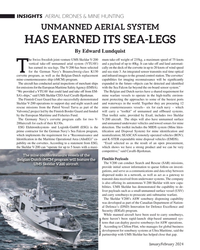 )
January 2024 - Marine Technology Reporter page: 12
)
January 2024 - Marine Technology Reporter page: 12INSIGHTS AERIAL DRONES & MINE HUNTING UNMANNED AERIAL SYSTEM HAS EARNED ITS SEA-LEGS By Edward Lundquist he Swiss-Swedish joint-venture UMS Skeldar V-200 mum take-off weight of 235kg, a maximum speed of 75 knots vertical take-off unmanned arial system (VTUAV) and a payload of up to 40kg. It can take
-
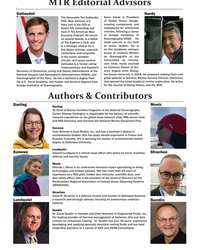 )
January 2024 - Marine Technology Reporter page: 6
)
January 2024 - Marine Technology Reporter page: 6MTR Editorial Advisors Gallaudet Hardy The Honorable Tim Gallaudet, Kevin Hardy is President PhD, Rear Admiral, U.S. of Global Ocean Design, Navy (ret) is the CEO of creating components and Ocean STL Consulting and subsystems for unmanned host of The American Blue vehicles, following a career
-
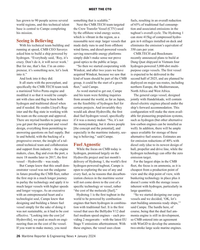 )
January 2024 - Maritime Reporter and Engineering News page: 26
)
January 2024 - Maritime Reporter and Engineering News page: 26team took ? eet,” said Campe. northern Europe, the Mediterranean, a marinized Volvo Penta engine and As word started to get out, Campe North Africa and West Africa. modi? ed it so that it would be compli- and his team were ? elding inquiries The general cargo vessel, designed ant with class and ? ag
-
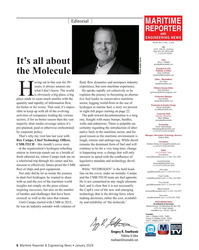 )
January 2024 - Maritime Reporter and Engineering News page: 6
)
January 2024 - Maritime Reporter and Engineering News page: 6Editorial MARITIME REPORTER AND ENGINEERING NEWS M A R I N E L I N K . C O M HQ 118 E. 25th St., 2nd Floor New York, NY 10010 USA T +1.212.477.6700 CEO John C. O’Malley It’s all about [email protected] President & COO Publisher & Editor Greg Trauthwein the Molecule Photo Justin Zurre trauthwein@ma
-
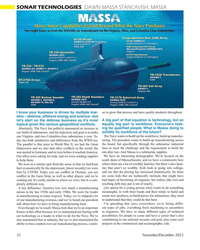 )
November 2023 - Marine Technology Reporter page: 32
)
November 2023 - Marine Technology Reporter page: 32SONAR TECHNOLOGIES DAWN MASSA STANCAVISH, MASSA ue to grow that process and have quality products throughout. I know your business is driven by multiple mar- kets – defense, offshore energy and science –but let’s start on the defense business as it’s most A big part of that equation is technology
-
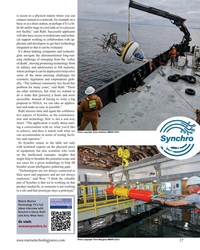 )
November 2023 - Marine Technology Reporter page: 27
)
November 2023 - Marine Technology Reporter page: 27? ll broader ocean intelligence gathering gaps. “Technologists are not always connected to their users and engineers and are not always marketers,” said West. “I think the valuable part of Synchro is that we’re working on that product market ? t, so someone is not working in a silo and that prototype stays
-
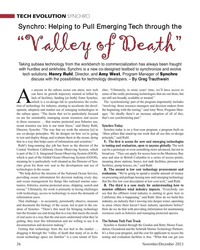 )
November 2023 - Marine Technology Reporter page: 26
)
November 2023 - Marine Technology Reporter page: 26been fraught with hurdles and sinkholes. Synchro is a new co-designed testbed to synchronize and evolve tech solutions. Henry Ruhl, Director, and Amy West, Program Manager of Synchro discuss with the possibilities for technology developers. – By Greg Trauthwein s anyone in the subsea sector can attest
-
 )
November 2023 - Marine Technology Reporter page: 21
)
November 2023 - Marine Technology Reporter page: 21The REPMUS Exercise 2023 took place between September 11- 29, 2023 at the Portuguese Navy’s Operational Experimentation Center in Tróia and Sesimbra Navy facilities. The NATO Maritime Geospatial, Meteorological and Oceanographic Centre of Excel- lence directly supports the Portuguese Navy during this
-
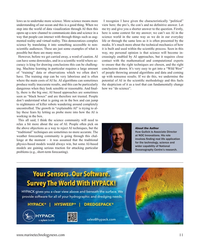 )
November 2023 - Marine Technology Reporter page: 11
)
November 2023 - Marine Technology Reporter page: 11techniques are chosen, and the right ing. Machine learning in particular requires a large amount conclusions drawn. It’s very easy to get into a “Wild West” of “training” data or observations which we often don’t of people throwing around algorithms and data and coming have. The training step can be
-
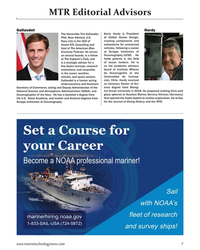 )
November 2023 - Marine Technology Reporter page: 7
)
November 2023 - Marine Technology Reporter page: 7MTR Editorial Advisors Gallaudet Hardy The Honorable Tim Gallaudet, Kevin Hardy is President PhD, Rear Admiral, U.S. of Global Ocean Design, Navy (ret) is the CEO of creating components and Ocean STL Consulting and subsystems for unmanned host of The American Blue vehicles, following a career
